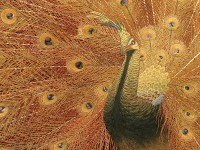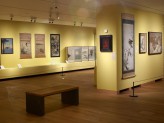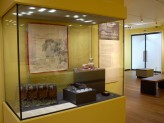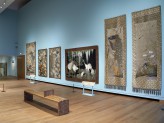Threads of Silk and Gold: Ornamental Textiles from Meiji Japan
(from 9th Nov 2012 until 27th Jan 2013)Discover exquisite embroideries, dyed silk and velvet panels, tapestries, and appliqué works

- This is a visual browsing tool that maps objects in this publication, gallery or collection trail by date of creation onto a timeline.
- The circular markers indicate where objects are on the timeline.
- The size of the markers indicates the relative number of objects at that point on the timeline.
- Hover over a marker to find out which objects are represented at that point in time.
- To expand, collapse or hide the timeline, click these symbols
 found at the top right of the timeline.
found at the top right of the timeline.
- 1850
- 1860
- 1870
- 1880
- 1890
- 1900
- 1910
- 1920
Introduction
‘From the thickest of satins, plain or decorated with designs in brocade, to the most gossamer-like gauzes, every combination of silk and gold thread has been carried to perfection…’
(Sir Rutherford Alcock, Art and Art Industries of Japan, 1878)
In the mid-1850s, Japan was forced by the Western nations to open its doors to the outside world after more than 200 years of self-imposed isolation. The opening of Japan led to a fascination in the West for all things Japanese, known as Japonisme. During this period of Japan’s history, known as the Meiji era (1868-1912), Japanese prints, ceramics, metalwork, and lacquerware became hugely fashionable in the West.
Also enormously popular at the time, but little known today, were non-costume Japanese textiles that were made specifically for the Western market as art objects or for interior decoration. These exquisite embroideries, dyed silk and velvet panels, tapestries, and appliqué works became some of Japan’s best-known export items. No fashionable Victorian home was without its Japanese drapes and hangings. They were also displayed at international exhibitions, and presented as diplomatic gifts from the Japanese imperial household and government.
The textiles in this exhibition are mostly drawn from the newly-acquired collection of the Kiyomizu Sannenzaka Museum in Kyoto. Pieced together from around the world, this outstanding collection has never been displayed before. These textiles are enhanced with additional objects from private collections and the Ashmolean’s own holdings.
Eastern Art Online presents an online version of Threads of Silk and Gold to provide a taste of the exhibition on display in the Ashmolean's Special Exhibitions Galleries. It enables visitors to browse and search all exhibition objects and their high-quality zoomable images online.
A fully illustrated catalogue of the exhibition is also available to purchase from the exhibition shop, or online here.
Was located in
See also
Notice
Objects from past exhibitions may have now returned to our stores or a lender. Click into an individual object record to confirm whether or not an object is currently on display. Our object location data is usually updated on a monthly basis, so please contact the Jameel Study Centre if you are planning to visit the museum to see a particular Eastern Art object.
© 2013 University of Oxford - Ashmolean Museum









